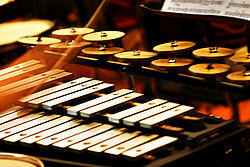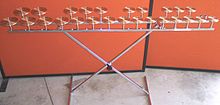 | |
| Percussion instrument | |
|---|---|
| Classification | Percussion |
| Hornbostel–Sachs classification | 111.22 (Percussion plaques) |
Crotales (/kroʊˈtɑːleɪz/), sometimes called antique cymbals, are percussion instruments consisting of small, tuned bronze or brass disks. Each is about 10 cm (4 in) in diameter with a flat top surface and a nipple on the base. They are commonly played by being struck with hard mallets. However, they may also be played by striking two disks together in the same manner as finger cymbals, or by bowing. Their sound is rather like a small tuned bell, only with a much brighter sound, and a much longer resonance. Like tuned finger cymbals, crotales are thicker and larger; they also have slight grooves in them. The name comes from the Greek crotalon, for a castanet or rattle.
Modern crotales are arranged chromatically and have a range of up to two octaves. They are typically available in sets (commonly one octave) but may also be purchased individually. Crotales are treated as transposing instruments; music for crotales is written two octaves lower than the sounding pitch, to minimize ledger lines.
Crotal bells are a type of small bell, mostly medieval. A different form of crotal is found in Prehistoric Ireland. The National Museum of Ireland and British Museum have several examples on display dating from the late Bronze Age (c. 800 BC) which were found in the Dowris Hoard, alongside various brass wind instruments. These are bronze cylinders in the rough shape of a bull's testicle, with a piece of baked clay or a pebble inside. It is presumed they functioned as a type of rattle. The hoard had 48 of them in total, in two sizes. Only two other examples are known, both Irish.[1]

Uses
One of the earliest uses of crotales in the orchestral repertoire is Hector Berlioz's Roméo et Juliette (1839). Other classical pieces featuring crotales include Claude Debussy's Prélude à l'après-midi d'un faune and Maurice Ravel's own orchestration of his Alborada del gracioso.[2]
The contemporary American composer John Adams also uses them in many of his more colourful orchestral pieces such as Short Ride in a Fast Machine.[3]
Progressive rock drummer Neil Peart of Rush used crotales as part of his basic drum kit for several years and featured them in the introduction to YYZ.
Progressive rock drummer Alan White of Yes uses crotales in the middle instrumental section of "Awaken" from Going for the One.
Rock drummer and soundtrack composer Stewart Copeland featured crotales frequently in the music to the PlayStation One platforming-game Spyro the Dragon.
Progressive rock/metal drummer Gavin Harrison uses ice bells as unpitched crotales on tour with Porcupine Tree.[4]
Experimental percussionist Eli Keszler uses dampened crotales in his music.[5]
References
- ^ Wallace, Patrick F., O'Floinn, Raghnall eds. Treasures of the National Museum of Ireland: Irish Antiquities, 2002, Gill & Macmillan, Dublin, ISBN 0717128296
- ^ Karl Peinkofer and Fritz Tannigel, Handbook of Percussion Instruments, (Mainz, Germany: Schott, 1976), 61.
- ^ May, Thomas (ed.). The John Adams Reader: Essential Writings on an American Composer. Pompton Plains, N.J.: Amadeus, 2006. p. 108
- ^ "Gavin Harrison - Drum Kit Tour".
- ^ "Eli Keszler - Against the Clock".